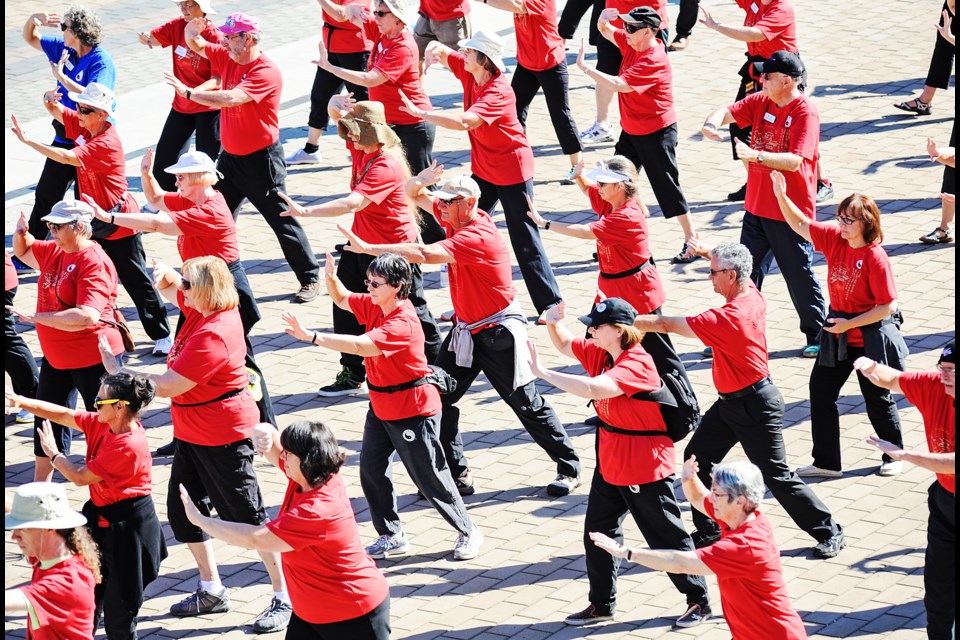As an army of 300 or so people in red T-shirts at Jack Poole Plaza moved their bodies in a slow and deliberate motion, almost like they were pushing and pulling through an imaginary force field, Wayne Yee stepped up to the podium to talk about tai chi as part of Saturday’s international awareness day for the Taoist Tai Chi Society.
If you knew nothing about the exercise other than seeing it listed in the seniors’ activities pages of your local community centre brochure, you might have been surprised to hear a testimonial from a fit-looking man who looked to be nowhere near retirement age. Not to mention from somebody who is also a recreational hockey player.
Yee said he received a concussion during a game, and that injury led to headaches and debilitating vertigo attacks.
“When you have that kind of impact to your brain, usually good things don’t happen,” he said. “It’s the kind of injury that really takes the energy out of you and it’s also very easy with that kind of brain injury to stay in bed, keep the blinds closed, and heavily medicate yourself to deal with the pain.”
Yee instead turned to tai chi, which he credits with helping him to the point of being virtually symptom-free.
A simple description of tai chi is that it’s a mind-body exercise of Chinese origin that dates back centuries. It is also described as an exercise that is meditation in motion, which has led to various, mostly-Western led studies about the healing effects of this specific meditation. Yee said he found tai chi an important part of his recovery because the stillness of movement calmed his brain.
Fung Loy Kok Taoist Tai Chi Pacific Region president and instructor Verity Rolfe explained further. “It has big effects on our minds as it calms, reduces stress and, as those things happen, the mind becomes clearer,” she said. “And physically, there’s a powerful effect, too, as it’s very strengthening even though it kind of looks lightweight. I think one of the most amazing things about tai chi is that it helps the body become more elastic.”
While the practice is gentle and is hugely beneficial for seniors, those with mobility issues, or those recovering from injury, Rolfe added young bodies and minds can also benefit.
Rod Edwards, a mathematician professor at the University of Victoria who showed up for the day along with others from across the province, said he started tai chi decades ago, when he was 21, as he found it offered good balance to his academic (read: sitdown) lifestyle.
“Even though I was 21, I wasn’t as healthy as I thought I was,” he said. “When you see tai chi, it’s graceful and beautiful to watch but it’s surprisingly thorough as an exercise. It takes every part of your body, your tendons, ligaments, joints and even internal organs, and stretches and works them. It keeps everything vibrant and alive.”
Rolfe was also in her 20s when she started as part of the first Taoist Tai Chi Society class in Vancouver November 1982, 12 years after Taoist monk Moy Lin Shin founded this style in Canada.
While both Rolfe and Edwards said they were also drawn to the spiritual aspect of the practice as Taoist is also a blend of Buddhist and Confucian traditions (after all both spent their impressionable youth during the era of Age of Aquarius), they see the spiritual side perhaps being a draw once again.
Rolfe said she sometimes sees some frustration with the commercialization of spirituality with the young people she knows. “I think there’s a lot of people looking for a different kind of depth, or something that hasn’t lost its depth. In tai chi, there’s an ancient lineage and for us, in our particular organization, we really trace that back. We’re not making it up.”
rvblissett@gmail.com



